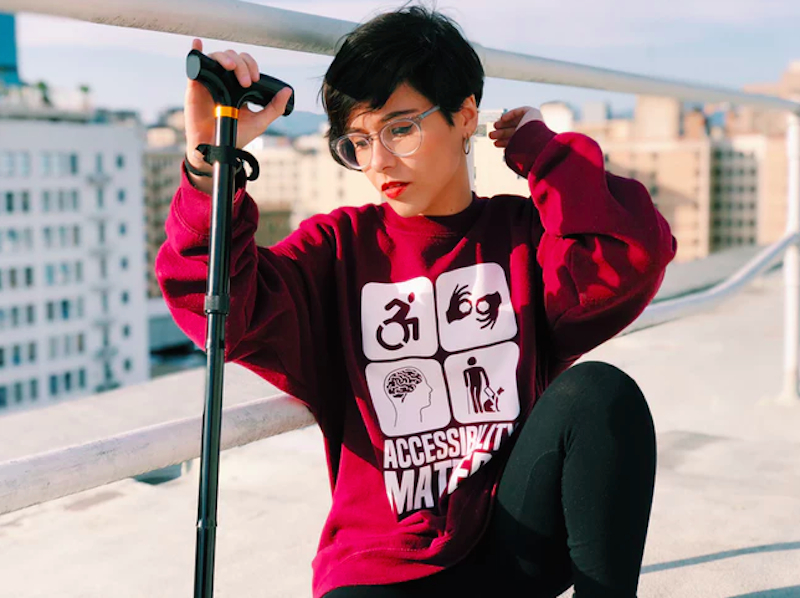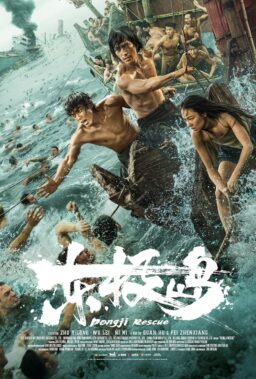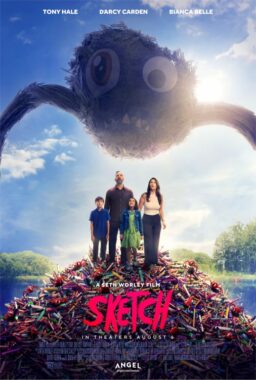Thumbnails is a roundup of brief excerpts to introduce you to articles from other websites that we found interesting and exciting. We provide links to the original sources for you to read in their entirety. This special edition of Thumbnails celebrates National Disability Employment Awareness Month, which runs through the entirety of October. Our contributor Scott Jordan Harris gave us the following article recommendations, and they provide a vital array of perspectives on the need for inclusivity in media.—Chaz Ebert
1.
“Growing Up, I Only Saw Half of Myself Represented On TV—That Needs to Change Now“: A personal essay from Bustle‘s Andrea Lausell about representations of Latinx people with disabilities. See also: Melissa Hung’s Huffington Post piece on “the most damaging way movies portray people with disabilities” and an article by prominent activist Vilissa Thompson on her Ramp Your Voice blog about portrayals of disability in the Black community.
“As I’ve grown into my adult years, it has made me happy to see Latinx-centered media begin to share stories of other marginalized non-disabled groups in the Latinx community (LGBTQ+, Afro-Latinx, Indigenous-Latinx). Representation is slowly improving with how these identities are viewed with TV shows like ‘One Day at a Time’ having a teenager like Elena Alvarez come out as queer and work through the emotions while seeking acceptance from her Cuban family. ‘Jane the Virgin’ highlights characters of color tackling the topic of immigration, all while making a political statement about our government and its treatment of people seeking a better life. Although these strides are giving us a diverse representation of Latinx culture and are being received fairly well by the community for being marathon-worthy, if Disabled Latinx were to be included in the narrative, would the public receive it as well? I’ve noticed that non-Latinx communities are just starting to embrace disabled narratives on their TV screens. Often, disabled representation in Hollywood, like in the novel-turned-film ‘Me Before You’ starring Emilia Clarke and Sam Claflin, portrays the harmful stereotype of disability being a burden. However, shows like ABC’s sitcom ‘Speechless’ have been a game changers for showing a disabled lead character happy with their life. But that’s just starting to happen now. Growing up, I learned to be ashamed of who I am because there were so few positive disabled Latinx representations on TV. Hearing from my Latinx community that disabled Latinx don’t exist — or that there’s ‘no need’ for us to be shown — told me that my place as a Disabled Latina within Latinidad wasn’t welcomed.”
2.

“Why are disabled actors ignored when it comes to roles like the Elephant Man?“: Asks The Guardian‘s Frances Ryan. See also: Ryan’s piece on the controversy regarding Netflix’s “Afflicted” series and Julie Rehmeyer’s Los Angeles Times essay on how Netflix is “televising prejudice against the chronically ill.”
“The BBC has been widely criticised over its decision to cast a non-disabled person in its remake of ‘The Elephant Man.’ The role of Joseph Merrick – who had severe physical deformities – will be played by the Stranger Things actor Charlie Heaton. Notably, actor Adam Pearson – who has neurofibromatosis type 1, a condition which was once thought to affect Merrick – has said he wasn’t even given the opportunity to audition. As Pearson told LBC, it’s part of a culture of exclusion for disabled actors. ‘It’s a systemic problem, not only in the BBC but industry-wide.’ From Dustin Hoffman in Rain Man to Eddie Redmayne in ‘The Theory of Everything,’ it’s routine for non-disabled actors to play disabled characters, often gaining critical acclaim in the process. At best, it takes work and exposure from talented disabled actors and further adds to an arts and culture that pushes disability representation – much like race, sex and class – to the sidelines. At worst, it sees non-disabled actors mimic the characteristics of a minority group without any involvement from the community it depicts.”
3.

“‘A Quiet Place’ proves there’s no excuse for using non-disabled actors to play disabled characters“: According to The Independent‘s James Moore. See also: Variety‘s Joe Otterson reports that Maysoon Zayid, who has cerebral palsy, will write and star in “an autobiographical comedy series in development at ABC,” while CNN‘s Wayne Drash analyzes the outrage over the portrayal of epilepsy on Netflix’s “Seizure Boy.”
“The movie is set in a post-apocalyptic world haunted by blind monsters that zero in on sound with the aid of supersensitive hearing. Silence is thus a matter of survival. Because her family uses American Sign Language (ASL) they have an advantage: they can talk to each other in a world where speaking can get you killed. The script could have fallen down at this point by having Simmonds perform a functional role without much else to do other than move the plot along for the other actors, including A-lister Emily Blunt, to shine. But it has more ambition than that. Simmonds’ Regan Abbott is a fully formed character; a stroppy teen, chafing against her parents’ overprotectiveness and haunted by what she sees as her role in her little brother’s death. It’s not just her deafness that is central to the plot: she is. She’s neither an afterthought, nor is she an inspiration, which is another trap films involving disability fall into. She’s a person. She’s also the best thing about a film that is full of good things. Director John Krasinski, who pushed to cast her, has further revealed that she changed one of the signed parts of the scripts in an important way that makes it better. In fact she elevates the whole project. As Kamran Mallick, the chief executive of Disability Rights UK, says, she brings ‘an extra dimension to the role which a hearing actor would not have been able to do.’”
4.

“Toppling Structures of Inequality in the Documentary Field“: A great article published at IDA by Nicole Opper.
“New Day Films, a distribution co-op created by and for independent documentary filmmakers in 1971, has recently been grappling with what it means to be truly representative of the broad spectrum of filmmakers that exists, including filmmakers of color, working-class filmmakers, trans and gender non-binary filmmakers and those with disabilities—groups that have historically been underrepresented or poorly portrayed in the industry. At our Annual Meeting in upstate New York this past June, a panel was convened to discuss the findings of an Equity and Representation task force, and to open up the conversation to all member-owners of the co-op. ‘Very often in the documentary space, I’m the only person of color,’ remarked Michael Premo. Premo is the director of ‘Water Warriors,’ the story of a community’s successful fight to protect their water from the oil and natural gas industry. ‘This is also sort of dually equated with poverty, which is equally as racist as being the token black guy.’ Cheryl Green, the director of ‘Who Am I To Stop It’—a documentary about individuals with traumatic brain injuries—shared her perspective as a filmmaker with acquired disabilities herself: ‘There is no one disability community. What is a film about disability? What is a person with a disability? We’re not a monolith. There’s not one way to talk about it; there’s not one way to present it. The main way disability is represented is non-disabled people parachuting in and filming a medical story. Usually it’s one that starts off as ‘That’s gross or scary or painful! Phew! They got better.’”
5.

“CinemAbility: The Art of Inclusion“: Scott Jordan Harris recommends Jenni Gold’s documentary in his RogerEbert.com review.
“‘CinemAbility’ is the most entertaining and comprehensive history of disability in American film and television ever made. In that sense it is the onscreen equivalent of Matthew F. Norden’s classic book Cinema Of Isolation: A History Of Physical Disability In The Movies, and Norden is prominent in the film’s opening scenes, explaining the early and generally disheartening history of Hollywood’s ideas about disability. Due prominence is given to Lon Chaney, an able-bodied actor notorious in the disabled community for making a career out of grotesque and exploitative parodies of disability. He often did so in partnership with director Tod Browning, who in 1932 made ‘Freaks’ with a cast of disabled actors. Norden uses ‘Freaks’ to make an important point about audience attitudes to disability then that is still relevant now: ‘Audiences couldn’t handle [‘Freaks’]. People supposedly went screaming down the aisles because what they were seeing on the screen were not able-bodied actors wearing tricky makeup … They were seeing authentic disabled people.’ But ‘CinemaAbility’ never feels like a lecture. It is structured like a conversation, with contributions from an array of industry heavyweights, including Marlee Matlin, Ben Affleck, Geena Davis, William H. Macy, Ben Lewin, Peter Bogdanovich and R.J. Mitte.”
Image of the Day

TV Guide‘s Alyssa Andrews explains “how TV is still failing people with disabilities,” in graphic novel form.
Video of the Day
The official trailer for Jenni Gold’s documentary, “CinemAbility: The Art of Inclusion,” reviewed above by Scott Jordan Harris.











